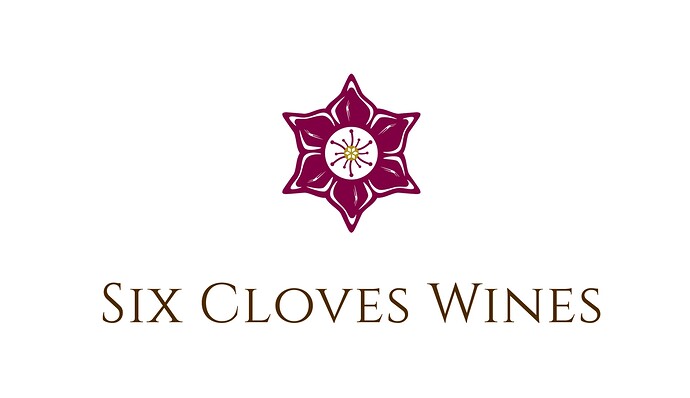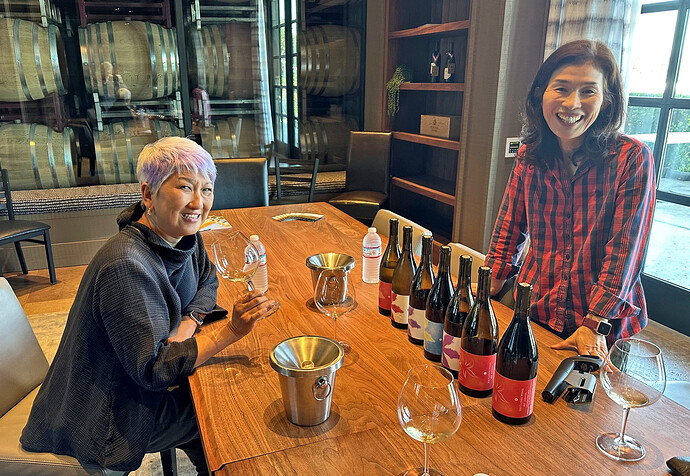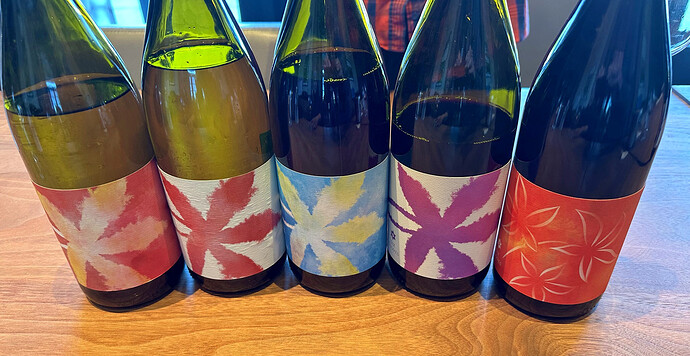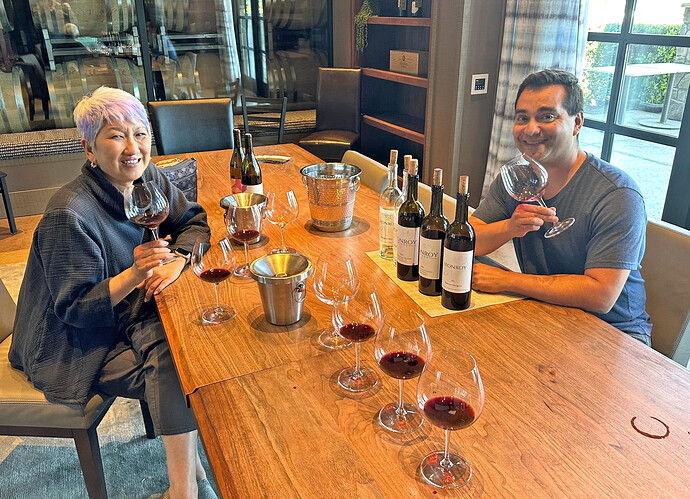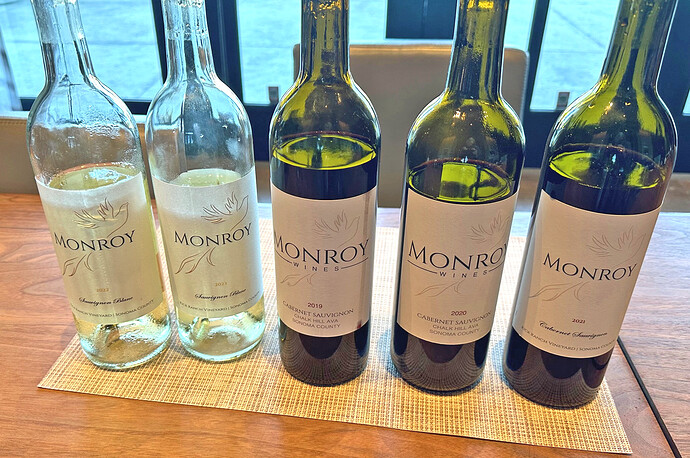Russian River Valley Winery Visits 8/22/24 – Freeman, Six Cloves, Benovia, Monroy
I visited winemakers from four wineries based in Russian River Valley with a friend a couple of weeks ago, and wrote a report for the Grape-Nutz.com website. For brevity, I’m posting notes here on just the two newer producers I visited, Six Cloves and Monroy. Notes on all four wineries are in the full Grape-Nutz report here: Russian River Valley Wineries - August 2024
Six Cloves Wines
The idea for this one-day wine tour with Jane in Russian River Valley started with the opportunity to taste some Six Cloves wines with owner / winemaker Sonoe Hirabayashi. I’ve known Sonoe for a few years but only tasted her wines for the first time earlier this year, so I was interested in trying more of them and in introducing the wines to Jane as well. We’d originally arranged to taste with her while we were visiting Freeman, where Sonoe has worked during crush the past couple of years, but a few days before our appointment she suggested tasting at Benovia Winery instead, as that’s where she’s working during this year’s crush season. I hadn’t been to Benovia for a number of years and had a little difficulty finding the place where Sonoe had arranged for our tasting, but it didn’t take too long for Jane and I to locate it. Sonoe saw us outside and welcomed us into a room with a long table inside of the large winery building, with a beautiful view of one of Benovia’s estate vineyards. After she gave us a quick tour of the winery building, Sonoe led us back into the room and we sat down to taste some of her Six Cloves wines.
Sonoe is originally from Nagano, Japan, and she worked for a number of years for a Japanese import/export business in New York City. Although she was successful there, she felt unfulfilled in that job. While in New York, Sonoe developed a passion for fine wines and learned that she had a very good palate. Her father was a highly-regarded apple grower, and her family has a generations-long background of producing sake, soy sauce, and miso – this family history is part of what led her to consider changing her career to one in the wine business. After seeing an article in Wine Spectator magazine about the UC Davis wine program she decided to apply there – she was accepted and earned a degree in viticulture & enology in 2011.
From the start, Sonoe was determined to follow a path to becoming a winemaker and to start her own wine label. She sought out highly-regarded vintners whom she felt she could learn from, to supplement her academic knowledge of wine science from UC Davis with the more intuitive and artistic side of winemaking. California vintners that Sonoe worked with along the way have included Ted Lemon at Littorai and Steve Matthiasson, and she spent Southern Hemisphere harvests working in New Zealand and Chile as well.
It was while Sonoe was working with Steve Matthiasson that she launched her Six Cloves wine label in 2017 with a Russian River Valley Chardonnay. The idea for her label name came from the business of a centuries-old ancestor who had sold medicinal herbs and spices – the logo of that business featured six cloves. Sonoe had a graphic designer friend create the elegant logo of her winery from that concept.
Sonoe has crafted her wines with the idea of making them food-friendly. She’s noted that her palate sensitivities, from her upbringing in Nagano, are different from those of most American winemakers – she said that her wines pair quite well with Japanese food though that’s not been her specific intent. To date, Sonoe has sold most of her small production of Six Cloves wines in Japan – she currently makes only around 300 cases per year. She said that it’s been a bit more difficult to gain a foothold in the crowded US wine market, particularly during the pandemic years. But since many of her wines are purposefully distinctive – not the typical California renditions of the varieties she works with – she feels optimistic. Sonoe’s wines display a light touch, with minimal winemaking intervention, and she’s now buying fruit only from organically-farmed vineyards. All of the Six Cloves wines undergo native fermentation and though some wines are aged only in older barrels, Sonoe uses some new French oak when she feels a wine will benefit from the additional complexity that can help bring. Whites are direct-pressed and barrel-fermented while some reds have a percentage of whole-cluster fermentation.
Sonoe started our tasting with her 2021 Alder Springs Vineyard Chardonnay. The vineyard is near Laytonville, at higher elevation not far from the Pacific coast in far northern Mendocino County – it must be one of the most remote vineyard sites in California. Grower Stuart Bewley farms about 150 acres of grapevines there, including some varieties that are rarely seen anywhere else in the state. The wine, made from Chardonnay clones 76 and 95, was fermented and aged in second-year and older French oak. This displayed citrus and pear aromas with undertones of flowers and stony minerals, with vibrant acidity and a long, fresh finish. The 2022 Linda Vista Vineyard Chardonnay comes from a vineyard in the cooler Oak Knoll District of Napa Valley – it was originally planted by Beringer in the 1980s and has been farmed organically for a number of years by Steve Matthiasson. There’s about 20% new French oak on this Chardonnay, made from the Olmo clone of the variety. Showing more of a stone fruit and spice profile than the previous wine, this had a broader mouthfeel with fine acidity.
We moved on to red wines, beginning with the 2021 Alder Springs Vineyard Pinot Noir. The wine was made from the 459 clone of Pinot, not seen much in California. The fruit was fermented with 50% whole clusters and the wine was aged in neutral French oak barrels for 10 months. This had a light color with intense floral and savory herbal aromas along with red fruit and earthy notes, lively acidity on the palate, and fine tannins on the long finish. Although we didn’t taste it on this occasion, I want to mention the Six Cloves 2022 Buf-Wehr Ranch Pinot Noir that I tasted at a wine event in April. Sourced from a Russian River Valley vineyard, this is from Pommard clone, and as with the previous wine it was 50% whole-cluster fermented before aging in neutral French oak. My notes from that earlier event said that this wine “was very aromatic, with flowers and bright fresh red fruit, along with medium body and a lively mouthfeel and finish.”
Jane and I tasted two more reds with Sonoe. The 2022 Castanon Vineyard Zinfandel comes from a site in Mendocino County’s Redwood Valley. Most Zinfandels are entirely destemmed prior to fermentation but this was fermented with about 30% whole clusters, and the wine was aged in 20% new French oak. With lighter color and more intense aromatics than most Zin, this was very distinctive, with bright raspberry, spice, and dried herb notes, a lively texture and moderate tannins. Our final Six Cloves wine was the 2019 “Magnolia” – this is a blend of 50% each Cabernet Sauvignon and Merlot, sourced from two vineyards in the cool Napa Carneros region and farmed by two of Sonoe’s UC Davis classmates, Shaunt Oungoulian and Diego Roig. The fruit was entirely destemmed and then each variety was fermented and aged separately for nine months (in second-year and older French oak) before blending. The wine featured subtle herbal notes plus darker berry fruit, earth, and spice, with medium body and good structure for continued development in the cellar.
Looking to the future, Sonoe may get more Cabernet fruit from Shaunt and Diego – to date, the 2019 “Magnolia” is the only wine she’s made from the vines they’re farming – and fruit from the West Sonoma Coast is another possibility. She also told me that next year she may be getting some “interesting whites” from Alder Springs Vineyard – can’t wait to find out more about that!
Sonoe had other work to attend to so it was a short tasting with her. But she had graciously arranged two additional tastings for Jane and me while we were at the Benovia facility, so we remained there for the next one. We knew that the next two tastings would be quick ones as well and joked that it was like the wine-tasting equivalent of speed dating!
This was a fun tasting with Sonoe – I’ve been wanting to visit with her and taste more of her wines for awhile so I was glad that we were able to get in this visit just on the cusp of this year’s winegrape harvest and crush. Sonoe presented a very nice group of her Six Cloves wines, with all of them displaying a subtle winemaking touch and fine balance – on the lower side for alcohol, yet lively and flavorful but not too lean. They show somewhat different renditions of California wines, so they’re both familiar and distinctive. I enjoyed all of the wines that Sonoe poured for us, and my favorites were the 2021 Alder Springs Vineyard Chardonnay, 2021 Alder Springs Vineyard Pinot Noir, 2022 Castanon Vineyard Zinfandel, as well as the 2022 Buf-Wehr Ranch Pinot Noir I’d tasted a few months earlier. The wines are mainly available through the Six Cloves website, and tasting with Sonoe can be arranged by appointment. It’s always exciting to see a relatively new vintner get off to such a strong start, and I’m looking forward to following the Six Cloves wines in the coming years.
Monroy Wines
The last of our three brief tastings at Benovia Winery was with Adolfo Hernandez, the owner / winemaker of Monroy Wines. Adolfo had poured his wines at a tasting event a few months earlier and I’d hoped to check them out but ran out of time and wasn’t able to try them there, so I was glad to be able to taste them on this occasion. Adolfo and his family lived in Saudi Arabia when he was growing up, and though alcohol was banned there, the closed American expat communities were given some leeway and a number of people there would make their own bootleg wine – Adolfo remembers helping his father make wine in plastic carboys from bottled grape juice. He moved with his family to California in 1997, and Adolfo attended Cal Poly San Luis Obispo where he earned a degree in molecular biology. After a few years, he gravitated toward the wine industry, where his background led him to a position in the wine lab at Clos du Bois in 2006. Since then, Adolfo has worked at a number of highly-regarded wineries including Eisele, Checkerboard, and Pahlmeyer in Napa Valley before coming to Benovia – he’s now starting his eighth harvest there, and he’s currently Benovia’s associate winemaker.
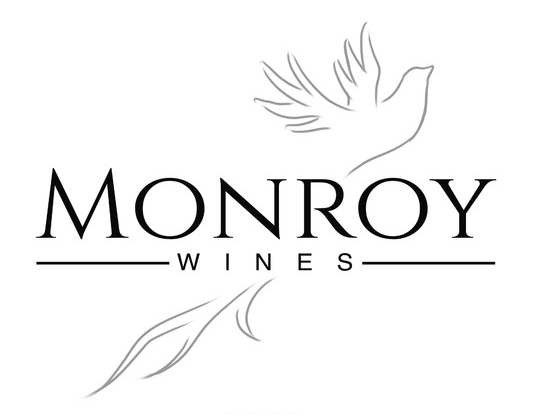
Adolfo and his wife Nohelia launched their own Monroy label with a Cabernet Sauvignon from the 2018 vintage, and they’ve added Sauvignon Blanc starting with the 2022 vintage. The winery name comes from Adolfo’s full name, Adolfo Hernandez de Monroy, and as an homage to his Guatemalan heritage, the bottle labels feature the image of a Quetzal, the country’s national bird. While he makes mostly Chardonnay and Pinot Noir in his position at Benovia, he produces only Sauvignon Blanc and Cabernet Sauvignon for Monroy, being very familiar with those varieties from his earlier work with Napa Valley wineries. Through 2020 – the current Monroy Cabernet vintage – Adolfo sourced his fruit from the Chalk Hill AVA in Sonoma County, but starting with 2021 he’s been getting all of his fruit, both Sauvignon Blanc and Cabernet Sauvignon, from Kick Ranch Vineyard. Located in Sonoma County’s Fountaingrove District AVA and initially planted in 2000, the hillside vineyard is on the western slope of Spring Mountain. It has a cooler climate than the eastern (Napa) side of Spring Mountain, and that’s something that Adolfo has consistently looked for in his vineyard sources.
Though he helped make some bolder wines when he worked in Napa Valley, Adolfo’s goal for Monroy is to make a more restrained style of wine that highlights savory and floral elements along with natural acidity. The combination of cooler vineyard sites, harvesting on the earlier side, and winemaking techniques all help in this respect. For his Sauvignon Blanc, Adolfo uses only the naturally floral Musqué clone for his Monroy wines. The fruit is direct pressed and made in both barrique and hogshead French oak barrels as well as stainless steel. A small percentage of new oak was used for both the 2022 and 2023 vintages, and Adolfo told us that the 2024 vintage of his Sauvignon Blanc will have no new oak. The wine is aged on the lees to help build more mouthfeel.
For the Monroy Cabernet Sauvignon Adolfo uses the labor-intensive method of barrel fermentation. He removes the barrel heads, adds the destemmed fruit, and closes the barrels again. They’re placed onto racks with special rollers so instead of typical punchdowns or pumpovers in larger fermentation vessels, the vented barrels are rolled in place for cap management. After fermentation is completed, Adolfo opens the barrels again, drains out the wine, removes the grape skins, and then fills the barrels once more, this time with the wine which is then aged for about 18-20 months prior to bottling. He uses only French oak, with around 50% new barrels. The barrel fermentation technique helps integrate the oak into the wine and adds greater texture that you often find in bigger Cabernets but without the overly ripe character and higher alcohol of those wines.
Both the Sauvignon Blanc and Cabernet Sauvignon are small-lot, low-production wines, and total annual production for the Monroy wines is only about 350 cases. Adolfo said that he currently sells about 50% of his wines direct to consumer and 50% via various trade accounts, and that he’d like to eventually keep a production level of around 500 cases per year. He plans to continue his focus on making only Sauvignon Blanc and Cabernet Sauvignon in the future.
Adolfo started Jane and me with tasting his Sauvignon Blanc from two vintages. The 2022 Kick Ranch Vineyard Sauvignon Blanc was fermented and aged in 15% new French oak, 25% neutral oak, and 60% stainless steel, spending about six months on the lees prior to bottling. This was quite floral on the nose, along with citrus and tropical fruit notes, and combining medium body with fine acidity and a clean finish. The 2023 Kick Ranch Vineyard Sauvignon Blanc had similar fermentation and aging to the 2022 vintage, with a little more time on the lees. With even more intense fresh stone fruit and tropical fruit plus floral aromas, this shared a similar texture and bright finish with the previous wine.
We moved on to three vintages of the Monroy Cabernet Sauvignon, all barrel-fermented. The 2019 Chalk Hill Cabernet Sauvignon was first. This featured currant and darker fruits, savory herbs, and undertones of pepper and oak, with medium-full body, fine structure, and a lively mouthfeel and finish. As with the 2019 release, the 2020 Chalk Hill Cabernet Sauvignon was sourced from a higher-elevation site within the appellation. A bit riper and bolder in profile than the previous wine, this showed more spice and vanilla/oak along with dark berry fruit and more tannic grip on the finish. Our final wine was the 2021 Kick Ranch Vineyard Cabernet Sauvignon from Adolfo’s new Cabernet fruit source in the Fountaingrove District. Displaying both red and black fruits, spice, and dried herbs on the nose plus undertones of flowers and stony minerals, this had both moderate richness and a lively texture on the palate along with good acidity and fine tannins – I think this has the potential to become the most complex of the three Cabernets. All three of the Monroy Cabernets are still quite young and deserve time in the cellar to more fully develop their fine potential.
Our tasting with Adolfo was a fun though fairly brief one, as he needed to get back to work – he told us that Benovia was bringing in their first fruit of the 2024 harvest the following day so he needed to prepare for that. The Monroy wines present a more elegant and refined take on the typical California renditions of their two varieties, particularly with regard to the Cabernet Sauvignon. While they’re not quite a “throwback” style, they’re definitely not in the big, ripe style of so many California Cabernets – there’s great balance to all of the Monroy wines, and it’s clear that the Cabernets are built to develop with aging rather than being immediate blockbusters. My favorites of the wines that Adolfo poured were the 2023 Kick Ranch Vineyard Sauvignon Blanc, 2019 Chalk Hill Cabernet Sauvignon, and 2023 Kick Ranch Vineyard Cabernet Sauvignon. The wines are available through the Monroy website as well as through select wine shops and restaurants, and tasting with Adolfo can be arranged by appointment. I really enjoyed our tasting with Adolfo – it was a fresh look at both Sauvignon Blanc and Cabernet Sauvignon, and Monroy should be a label to keep an eye on.
